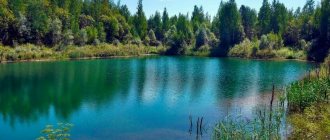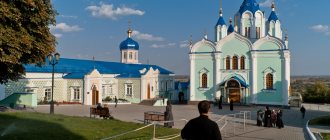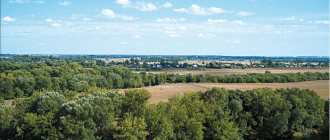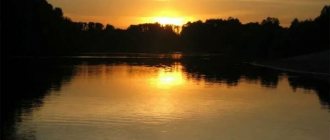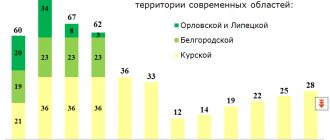General information about the Kursk region
Distinctive features
. Since the first Slavs settled in the Kursk lands, this territory has become a bone of contention between stronger neighbors. First, the Pereyaslav princes fought for it with the Chernigov princes, then the Lithuanian principality with the Horde, until Moscow liberated these lands from the Catholic Lithuanians.
Now the Kursk region continues to occupy an important strategic position. Transport routes connecting Moscow with Crimea pass through Kursk. During the Great Patriotic War, the famous Battle of Kursk took place here - a battle after which the initiative in the war forever passed to the Soviet troops.
Economic activity in the region is active, trade, transport, and the service sector are developing. But they don’t forget about traditional areas - just like decades ago, they mine iron ore, grow grain, sugar beets, and vegetables. Fortunately, the local soils are rich in black soil. Also here is one of the largest nuclear power plants - the Kursk Nuclear Power Plant.
The Kursk land has given birth to many talented and famous people. These are Saint Seraphim of Sarov, writer Arkady Gaidar, author of “Timur and His Team,” and artist Alexander Deineka, and famous humorist Vladimir Vinokur. The future General Secretary of the CPSU Central Committee, Nikita Sergeevich Khrushchev, was born in the village of Kalinovka, Kursk region, and promised to show “Kuzka’s mother” to the capitalist world. Surprisingly, the parents of another famous secretary general, Leonid Ilyich Brezhnev, also came from the Kursk lands.
Kursk is the heart of the Nightingale region. Not a city, but a song!
One of the symbols of the Kursk region is the Kursk nightingale - a unique species of songbird that can produce terli of particular beauty and complexity. Among the regional attractions, it is worth highlighting the Korennaya Hermitage Monastery, 30 km from Kursk, and noble estates, of which the most famous is the palace of the Baryatynsky princes in Maryino.
Monastery "Root Hermitage"
Geographical location
. The Kursk region is located in the west of the Russian Federation, in the central part of the East European Plain. In the north, the region borders with the Bryansk, Oryol and Lipetsk regions, in the south - with Belgorod and Voronezh, in the west - with Ukraine.
Located in the southwest of the Central Russian Upland, the Kursk region has a flat topography. The average height above sea level is 200 m. There are few reservoirs here, mostly artificial reservoirs. Of the more or less large rivers, five are worth noting: Seim, Psel, Svapa, Tuskar, Kshen.
Population.
Since the Kursk land had different masters in different historical eras, here we can find a mixture of very different dialects and even different groups of the peasant population: Sayans, Tsukans, Goryuns. The territory of the region was also actively populated by fugitive peasants, as well as migrants from the internal regions of the Russian kingdom, often sent to these lands on a voluntary-compulsory basis.
Now 96% of the region’s population are Russians, 1.3% are Ukrainians. In total, 1120 thousand people live in the Kursk region. The population is steadily declining every year: the mortality rate here is noticeably higher than the birth rate, and the flow of people wishing to move here from other regions is noticeably inferior to that of the neighboring Belgorod region. The male population is much smaller than the female population: 45.4% versus 54.6%. Population density is low: 37.3%.
Crime
. In the criminal ranking of regions, the Kursk region is in 48th place, and there is a trend towards a decrease in the number of crimes committed. There were no major or scandalous cases in this area. Mostly domestic crimes. Quite often, rape cases are featured in news reports, so parents of high school girls should teach their children to be careful. Corruption in government is also a common phenomenon.
Unemployment rate
in the Kursk region does not differ much from the national average. In 2012 it amounted to 5.11% (the Russian average is 5.45%). It must be said that there are not many large enterprises in the region, such as the Mikhailovsky Mining and Processing Plant in Zheleznogorsk or the Kursk Nuclear Power Plant, where new power units are now being built to replace the spent ones. But there are many medium-sized enterprises in the processing industry, primarily involved in food production. The average salary in the Kursk region is approximately 18,000 rubles, which is the average for the central regions, not counting the capital.
Kursk NPP in Kurchatov
Property value.
Housing prices in the Kursk region are pleasantly surprising. The average cost of one square meter in Kursk is one of the lowest in the Central Federal District - 38,353 rubles. This is explained by the low popularity of this region among migrants, the decline in population and the vacancy of housing stock. On the other hand, there are no such compelling reasons to neglect this city. Most likely, the reason is that the Kursk region is not yet a popular region, and its administration is not making enough efforts to create an attractive image of its fiefdom.
Climate
Kursk region - temperate continental. The average temperature here in July is +22°C, in January -7°C. The average annual precipitation is 550-600 mm per year. Peak precipitation occurs in the warm months, with more precipitation falling in the northwest of the region. There is quite a lot of snow, and it lies steadily from December to early March. The height of the snow cover reaches 20-40 cm.
Up ▲ — Reader reviews (3) — Write a review ▼ — Print version
| e-mail, city: St. Petersburg | |
The article contains a number of inaccuracies. Kursk was never part of the Smolensk and Suzdal principalities. In the XIV-XVI centuries. Kursk did not exist, so it could not be considered any “important defensive point of the Moscow state” at that time. The construction of the Kursk fortress dates back to 1596, and not to 1597. In 1727, the Belgorod province was formed, not the governorship; there was no “transformation” of the Belgorod province in 1749. Governorship and province are synonymous; there was no “transformation” of the Kursk “government” into a “province” in 1797 (this is a common misconception, widely represented in reference literature). As an important addition, we should point out the fact of the transfer from the Kursk province in 1925 of the city of Putivl with the adjacent district to the Ukrainian SSR.
| Andrey | 5 April 2014, 13:59:47 |
An excellent article, but I wanted to add a little)) Among the “migrants” in the period of the late 16th and early 17th centuries, there were a large number of so-called “Byar children”, this is a military class class, later they began to be called odnodvortsy. They were allocated land on which they farmed, and the head of the family was in the military service of the state. Representatives of the same palace occupied officer positions. The settlements they founded often bore the surnames of the founders in their names. This was the case with my ancestors, who founded the settlement, which is now called Apalkovo, and in the 1645 census books it was written as Opalkova. Later, other members of the same palace, for example the Lobyntsevs, began to gain strength in this village. These same-palaces became the founders of many families that are considered Kursk. As for the national composition, in the Kursk province of 18-19 many called themselves Sevryuks (most likely these are descendants of northerners, Severians). There were also nationalities who called themselves Sayans, Goryuns, after 1917 they became Russians. And also in the Kursk region there is a huge number of Ukrainians who have forgotten their roots.
| passer-by | 9 April 2014, 09:52:05 |
| city: Kursk | |
To the established symbols of the Kursk region we must add the Kursk tram - the 2nd in Tsarist Russia, opened in 1898 (1st - in Nizhny Novgorod).
Cities of the Kursk region
Kursk
(423 thousand people) - the capital of the region. A city with a developed but dilapidated infrastructure that could use a serious overhaul. The city's economy is balanced; there are enterprises in mechanical engineering, instrument making, chemical and food industries. Pros: relatively favorable environmental conditions, low housing prices. Cons: problems with roads, transport infrastructure, housing and communal services.
Triumphal Arch in Kursk
Zheleznogorsk
- the second largest city with a population of about 100 thousand people. Located 90 km northwest of Kursk. It was founded after the decision was made to develop the Mikhailovskoye field of the Kursk magnetic anomaly. Now Mikhailovsky GOK is the main city-forming enterprise of the city, forming 70% of the budget of Zheleznogorsk. Another large enterprise is Rudavtomatika.
“Moonscapes” of Mikhailovsky GOK
The city's infrastructure is quite well developed. There are many green spaces, cultural institutions, and universities. Cons: after all, the specifics of the city as a place of iron ore mining leave an imprint on life. Despite this, from an environmental point of view, everything is not so bad here. The Kursk region is one of the best in Russia in terms of ecology and took fourth place in the Green Patrol rating of regions.
Questions and answers
What is the vehicle code in the region?
Region code - 46
What time zone is it in?
The Kursk region lives according to Moscow time. Time zone UTC +3
How many settlements are there in the Kursk region?
There are 2,807 settlements in the Kursk region: 5 cities of regional significance, 5 cities of regional significance, 22 urban-type settlements and 2,775 rural settlements.
What is the total area of the subject?
The area of the region is 29.8 thousand km²
Flora and fauna
The natural zone of the Kursk region is quite diverse. There are various forests in the region. Bor is not typical for this area. If you are walking in a forest, then most likely it is the work of man. On the territory of the Kursk region there are birch and aspen forests, oak forests and hazel trees. Kursk residents love to collect mushrooms: boletus, boletus, boletus, russula and others.
Reeds, alder, reeds, willow, egg capsules, water lilies and various algae grow in swamps and ponds.
This climate and nature are good for different animals. The groves and forests are home to elk, wild boars and roe deer. Badgers also love the Kursk forests. The wolves were almost exterminated. But foxes, on the contrary, feel at ease in these parts. They hunt for game even in swamps. They love the hedgehogs and squirrels that live here. There are a huge number of lizards and even snakes on the ground. It’s not uncommon to see a viper or snake in the forest.
The world of birds in the forests of the Kursk region is diverse. Warblers, finches, and woodpeckers live here. There are also blackbirds and cuckoos, turtle doves, partridges and corncrakes, as well as the sung Kursk nightingales.
Autumn
Kursk autumn is very bright, colorful and warm, since the color scheme during this period is the most diverse. However, there are gloomy days in the region, characterized by cloudy skies and prolonged rains. September in this corner of Russia is considered a continuation of summer. During the day the temperature reaches +15 °C. In October, the air temperature is slightly lower, already up to +10 °C. At night in October the first frosts occur.
The climate of the Kursk region is quite humid. The area receives about 650 millimeters of precipitation per year. In warmer regions the area is slightly smaller, up to 500 millimeters.

